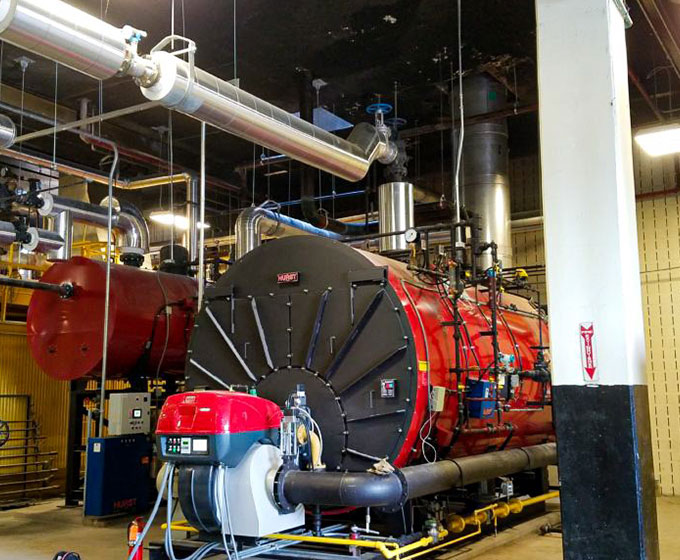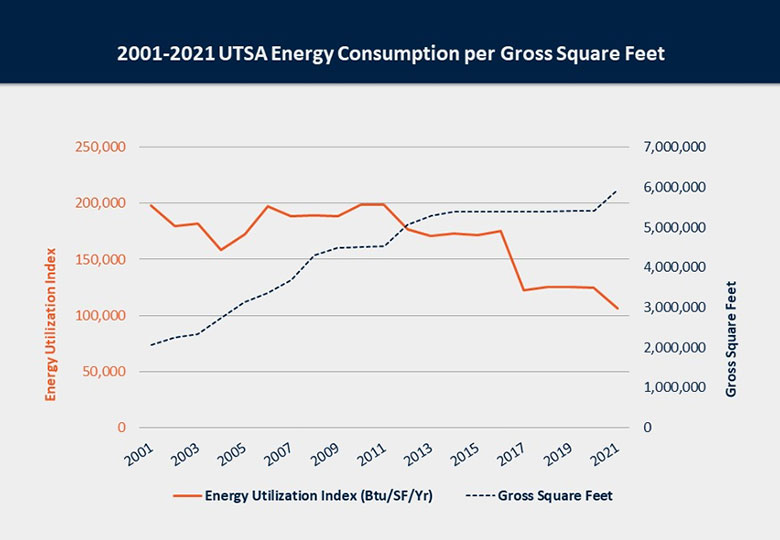
A boiler was installed at the North Thermal Energy Plant in 2018.
APRIL 25, 2022 — Over the past two decades, the UTSA Office of Facilities has prioritized energy efficiency and energy conservation strategies.
In addition to saving millions of dollars, the strategies have enabled the university to significantly decrease its average annual energy expenditure even while its enrollment and infrastructure have steadily increased.
To measure and track UTSA’s energy consumption, Facilities uses the Energy Utilization Index (EUI), which is defined as the ratio of total energy consumed annually to total building square feet. For an institution such as UTSA, where total building square footage increases rapidly and regularly, proportion-based measurements such as the EUI are the most reliable way to consistently determine energy utilization efficiency.

The UTSA energy utilization index increased in gross square feet from 2001 to 2021.
In 2001, the UT System Energy Utilization Task Force (EUTF) set an energy reduction stretch goal for UTSA to decrease its EUI by 20% over the next 20 years, a goal which the university has exceeded. In 2020, Facilities’ Energy and Utilities Management team reported that the university’s EUI had decreased by 37% since 2001. During this time, the square footage increased by 182% due to the more recent additions of the Science & Engineering Building (SEB), the Student Success Center, the Roadrunner Athletics Center of Excellence, the Mesquite Living Laboratory and Guadalupe Hall.
Careful planning and strategic innovation are key to Facilities’ energy efficiency success, as well as the department’s purposeful diligence in adhering to energy and water conservation code guidance.
“Renovations and new construction require the use of LED lamps, because less energy is required to light an LED bulb compared to a fluorescent light,” said Dagoberto Rodriguez, UTSA energy and utilities manager.
In addition to LED lighting retrofits, major improvements to UTSA buildings over the past two decades also include building envelope updates, as well as chiller and boiler replacements that enable more reliable and efficient interior heating and cooling.
“When we replace older equipment that is beyond its useful life, the new equipment typically provides greater energy-saving benefits,” said Rene Colunga, UTSA energy and utilities management director. “For example, a chiller replaced at UTSA’s North Thermal Energy Plant in 2014 notably outperformed the old equipment in energy efficiency, decreasing the university’s environmental impact from greenhouse gas emissions.”
Additionally, Facilities has implemented vending machine de-lamping, HVAC controls and system retrofits, electric load shedding and variable speed fume hood retrofits, as well as lower-tech strategies such as daylighting—the practice of maximizing internal lighting from sunlight through windows, skylights and reflective surfaces—to help reduce energy use and provide long-term savings. Other energy efficiency enhancements include the environmentally friendly, cost-effective, roof-mounted solar array systems found on the H-E-B Student Union and SEB at the UTSA Main Campus and the Durango Building at the Downtown Campus.
UTSA Facilities is currently partnering with student employees to organize utility cost and consumption data. This information will help the team better identify new opportunities for energy efficiency on campus.
For example, recent electrical rate increases have presented cause to re-evaluate projects which were previously considered, such as new solar arrays and combined heat and power.
“In an ever-changing environment, yesterday’s good idea could easily become tomorrow’s great idea. We are excited to see what our Roadrunners suggest,” Colunga said.
In the meantime, Facilities asks the Roadrunner community to do their part to help conserve energy while on campus.
“Turning off lights in offices and classrooms when they are vacant contributes big to energy savings,” Colunga said. “With your individual—but impactful—contributions, UTSA can continue boosting energy efficiency savings that will have a lasting impact on the community.”
UTSA Today is produced by University Communications and Marketing, the official news source of The University of Texas at San Antonio. Send your feedback to news@utsa.edu. Keep up-to-date on UTSA news by visiting UTSA Today. Connect with UTSA online at Facebook, Twitter, Youtube and Instagram.
Move In To COLFA is strongly recommended for new students in COLFA. It gives you the chance to learn about the Student Success Center, campus resources and meet new friends!
Academic Classroom: Lecture Hall (MH 2.01.10,) McKinney Humanities BldgWe invite you to join us for Birds Up! Downtown, an exciting welcome back event designed to connect students with the different departments at the Downtown Campus. Students will have the opportunity to learn about some of the departments on campus, gain access to different resources, and collect some giveaways!
Bill Miller PlazaCome and celebrate this year's homecoming at the Downtown Campus with food, games, giveaways, music, and more. We look forward to seeing your Roadrunner Spirit!
Bill Miller PlazaThe University of Texas at San Antonio is dedicated to the advancement of knowledge through research and discovery, teaching and learning, community engagement and public service. As an institution of access and excellence, UTSA embraces multicultural traditions and serves as a center for intellectual and creative resources as well as a catalyst for socioeconomic development and the commercialization of intellectual property - for Texas, the nation and the world.
To be a premier public research university, providing access to educational excellence and preparing citizen leaders for the global environment.
We encourage an environment of dialogue and discovery, where integrity, excellence, respect, collaboration and innovation are fostered.